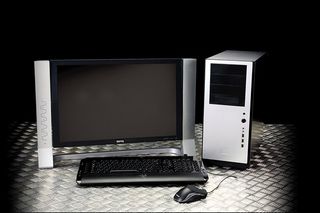Turn your cheap PC into a monster
Tune it up, trim the fat, overclock 'till it bleeds
4) At some point, you'll need to go back to step 1 and set your hard drive as the primary boot device. But not right now. Instead, on the final reboot, you'll be taken to the Vista home screen. Click past all the opening guff that appears - it might take some time as Windows examines your hardware - and in the Welcome menu uncheck the box that says 'Show this page when Windows starts'. You really don't want to see it again.
5) Now it's driver time. Inserting the Asus driver disc that came with your motherboard will bring up options to install all the drivers for your chipset, RAID controller, network card and audio, in one mouse click. The PC may restart a couple of times; that's fine. From this disc, you may also want Asus Update and Asus PC Probe II from the Utilities menu, to help you flash the BIOS (should you need to) and monitor temperatures.
6) Connect your PC to the internet and allow it to download all the Vista updates it needs. There are four hotfixes for graphics performance which may not install automatically. Grab them from: tinyurl.com/37wwco,tinyurl.com/2zvljr,tinyurl.com/2b48unandtinyurl.com/ys2baa. Now you'll need graphics drivers fromwww.nvidia.com. Click 'Download drivers', then 'Beta drivers'. Install the latest ones.
7) Now let's start working on Vista. First, the easy bit: we'll get rid of the sidebar. Simply right click on the sidebar icon in the Task Bar, click 'Properties' and deselect 'Start Sidebar when Windows starts'. Then close it down by right clicking and selecting 'Exit'. Now for the slightly-less-easy bit: open up the Start menu and type 'services.msc' in the search bar, and open the program that appears.

8) Behold: every service currently running on your PC. You don't need most of them. Type 'msconfig' in the search bar and open that - just as in XP, you can now disable unnecessary services from running at startup, freeing up system resources. You may want to turn User Account Control off too to prevent those nag screens (Control Panel>User Accounts and Family Safety> User Accounts) - although this does expose a security risk.
9) You'll probably want to turn off the Aero interface (Control Panel>Appearance and Personalisation> Personalisation>Window Colour & Appearance>Open classic appearance properties), which can hog background resources when you're gaming. If you're feeling brave, you may also want to head over to Control Panel>Uninstall A Program and click 'Turn Windows Features On and Off' in the left hand pane.
Sign up to the 12DOVE Newsletter
Weekly digests, tales from the communities you love, and more
10) Hear that grinding noise? That's Vista trying to index every file on your hard drive, from the donkey movies you keep hidden, to each individual texture of Half-Life 2. It is a pointless, fruitless task only Microsoft could imagine you would want your PC to do by default. Investigate Control Panel>System & Maintenance>Indexing Options to put a halt to Vista's constant and obsessive disk thrashing.
Overclock the hell out of it
We'll start by tweaking the motherboard settings - the CPU, the FSB and the RAM timings - before overclocking the graphics card. That's because these all need to be done in the BIOS and we want our PC running nice and smoothly before we begin to push its 3D limits. The key to successful overclocking is to change things in small increments, and then boot into Windows to test stability before going further. A good way to see if your PC can cope with the new settings is to run a few tests from something like 3DMark for a few minutes. If it locks up or crashes, you need to drop the last change to your settings.
Most Popular


